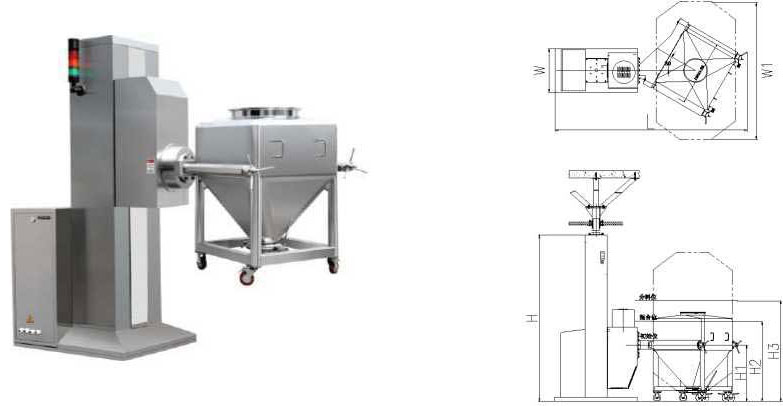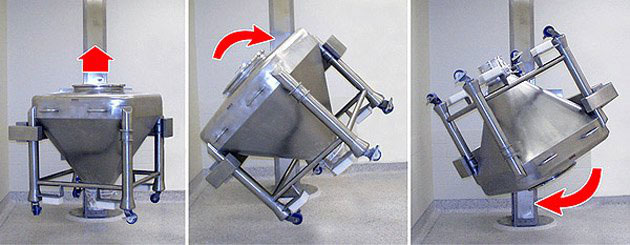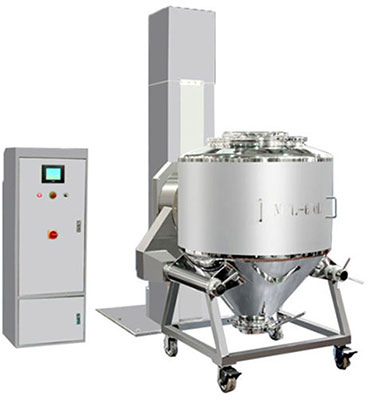
A "Bin Blender" is a type of industrial equipment used in pharmaceutical, food, chemical, and other processing industries to blend or mix dry granular or powder materials.
It's designed to ensure homogenous mixing of different components to create a consistent final product.
Bin blenders come in various types and specifications to accommodate different batch sizes, mixing requirements, and operational preferences. Here's a general description along with some common types and specifications:
Working Principle of a Bin Blender?

Product Description: A bin blender consists of a blending container or bin equipped with a lid and mixing blades, as well as a drive mechanism to rotate and blend the contents inside the bin.
The bin can be cone-shaped or cylindrical and is often made from stainless steel or other suitable materials for ease of cleaning and preventing cross-contamination.
Specifications: The specifications of a bin blender can vary widely based on the manufacturer, the intended application, and the specific requirements of the industry.

Here are some common specifications:
- Capacity: Bin blenders come in various sizes, ranging from a few litters to several thousand litters, depending on the application and batch size.
- Material: The construction material is typically stainless steel for compliance with hygiene and regulatory standards. The type of stainless steel used may vary depending on the material being processed.
- Blending Mechanism: Bin blenders are equipped with various mixing mechanisms such as paddle blades, ribbon blades, or other designs to ensure thorough blending.
- Speed and Rotation: The rotation speed of the bin and the duration of blending can be adjusted to achieve the desired mixing results.
- Control System: Bin blenders may feature manual, semi-automatic, or fully automatic controls for ease of operation and consistency in mixing.
- Safety Features: Safety interlocks, overload protection, and other safety features ensure the equipment operates securely.
- Discharge Mechanism: Bin blenders include a discharge port or valve to remove the blended material from the bin once the mixing process is complete.
- Cleaning and Maintenance: Easy access for cleaning, maintenance, and validation procedures is essential for maintaining hygiene and efficiency.
Please note that specific specifications can vary based on the manufacturer and the model of the bin blender.
Certainly, here's a table outlining different types of bin blenders along with a brief description of each type:
| Type of Bin Blender | Description |
| Double Cone Blender | Features two connected cones forming the blending vessel. Suitable for blending free-flowing powders and granules. The rotation causes materials to cascade and mix. |
| V-Blender | Shaped like a V with twin blending shells. Materials are loaded into the V and mixed by the rotation of the shells, creating a tumbling and folding motion. |
| Octagonal Blender | Bin has an octagonal shape, providing more surfaces for mixing and better homogeneity. Often used for delicate or fragile materials. |
| Rotary Drum Blender | Uses a rotating drum as the mixing vessel. Suitable for larger batch sizes and materials with varying densities and particle sizes. |
| Bin Activator Blender | Combines a bin and an activator to promote material flow. Suitable for difficult-to-blend materials or those prone to bridging. |
| Paddle Blender | Equipped with horizontal or inclined paddles for gentle blending. Suitable for materials that are shear-sensitive or cohesive. |
| Ribbon Blender | Features an outer ribbon and an inner helical agitator for efficient mixing. Ideal for materials with differing densities or particle sizes. |
| Fluidized Bed Blender | Uses air to fluidize and blend materials, creating a homogenous mixture. Suitable for materials with different particle sizes and densities. |
| Tumbling Blender | A simple type that relies on the tumbling action of the materials to achieve mixing. Suitable for less demanding blending applications. |
The key features of a bin blender can vary depending on the specific model and manufacturer, but here are some common features that are often found in bin blenders across different types and applications:
- Blending Mechanism: Bin blenders are equipped with various types of mixing blades or agitators, such as paddle blades, ribbon blades, or tumbling shells, to ensure thorough and uniform blending of materials.
- Uniform Mixing: Bin blenders are designed to achieve consistent mixing of materials, resulting in a homogenous blend with minimal segregation.
- Variable Speed Control: Many bin blenders offer adjustable rotation speeds, allowing operators to customize the mixing intensity based on the characteristics of the materials being blended.
- Batch Size Flexibility: Bin blenders come in various sizes to accommodate different batch sizes, from small laboratory-scale batches to large-scale industrial production.
- Hygienic Design: Bin blenders are often constructed using sanitary materials like stainless steel to meet industry standards for hygiene and cleanliness. Smooth surfaces and easy-to-clean designs prevent cross-contamination and facilitate thorough cleaning between batches.
- Loading and Discharging: These blenders feature convenient loading and discharging mechanisms, such as hinged lids, discharge valves, and quick-release clamps, to streamline the loading and unloading process.
- Safety Features: Safety interlocks, emergency stop buttons, and overload protection ensure the safety of operators and prevent damage to the equipment during operation.
- Control Options: Bin blenders may come with various control options, including manual, semi-automatic, and fully automatic controls. Some advanced models might offer programmable settings and digital displays for precise control over the blending process.
- Validation and Documentation: In industries with strict regulatory requirements, bin blenders may offer features to facilitate validation processes, including data logging, batch history records, and compliance with Good Manufacturing Practices (GMP) guidelines.
- Versatility: Bin blenders can handle a wide range of materials, from dry powders to granules, making them versatile for use in various industries like pharmaceuticals, food processing, chemicals, and more.
- Customization: Some manufacturers offer customization options to tailor the bin blender to specific processing needs, including specialized blending mechanisms, material finishes, and additional features.
- Energy Efficiency: Many modern bin blenders are designed with energy-efficient motors and mechanisms to reduce operational costs and environmental impact.
- Easy Maintenance: Bin blenders with easily accessible parts, tool-free disassembly, and user-friendly maintenance procedures help minimize downtime and upkeep efforts.
- Process Validation: Bin blenders may provide features that allow for validation of the mixing process, including options for real-time monitoring, data recording, and adherence to regulatory standards.
- Integration: Advanced bin blenders might offer compatibility with automation systems, allowing for seamless integration into larger production lines and control networks.
IBC Bin Blenders

Remember that the availability of these features can vary depending on the manufacturer and the specific model of the bin blender. When considering a bin blender for your needs, it's important to thoroughly review the product specifications and consult with the manufacturer or supplier to ensure that the features align with your requirements.
Bin Blender – IBC Bin / Cage/ Conta Blender
Process & Operation
SHREE BHAGWATI Bin Blender or SHREE BHAGWATI Conta Blender are used mainly for blending of dry powders for tablets production and capsules, which facilitates better flow for tablets and capsules. This is a closed contained, totally dust free single step transfer system. Bin Blender can handle more than one different size of IBC Bins.
In granulation room the dry granules enter to the IBC container for blending through a dust free connection and the same IBC container is loaded over to the blender for blending. The IBC Bin locked in the resting frame in 15° then lifted by hydraulic system in 15° inclined position after that the IBC bin rotates for blending with 3 dimension action. This same container after blending loaded over the tablet press for unloading in to the tablet press hoppers.
Salient Features
- Design is cGMP – Current Good Manufacturing Practices compliance.
- All Product contact parts AISI 316/316L & non contact parts AISI 304.
- Available Capacity: 25 kg to 650 kg batch size.
- Interchangeable different capacity of IBC Bin on same machine for mixing.
- Enclosed rigid drive with reduction gear box and motor.
- Hydraulic power pack system for lifting of product bin for mixing.
- Charging hole with hinged lid with seal for charging and cleaning.
- Product container having discharge with butterfly valve and man hole.
Safety Features
- Safety railing provided for rotating area of product container.
- Overload relay protection & Emergency stop button.
